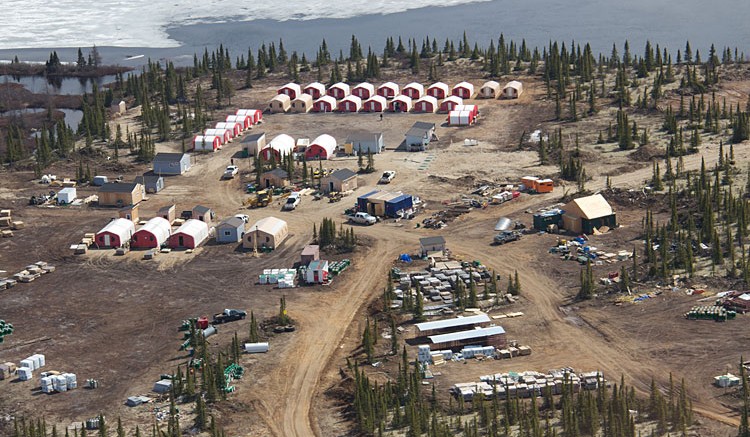VANCOUVER – A preliminary feasibility study concluded the East and West deposits at Champion Iron Mines‘ (CHM-T) Consolidated Fire Lake North project could produce 9.3 million tonnes of concentrate grading 66% iron for almost 20 years, but lingering uncertainty over how to move that concentrate to market is hurting project economics and investor confidence.
Consolidated Fire Lake North (CFLN) is part of Champion’s Fermont property holdings, which cover 750 sq. km in northeastern Quebec. CFLN is the most advanced of the five iron ore projects within the Fermont portfolio. And it is undoubtedly in iron mining territory: CFLN sits just north of ArcelorMittal‘s (MTN-N) Fire Lake mine and 60 km south of Cliff Natural Resources (CLF-N) Bloom Lake mine.
The project boasts a large resource: 693 million measured and indicated tonnes grading 31.5% total iron plus 522 million inferred tonnes grading 30.1% iron. However, the prefeasibility study only considered 465 million tonnes of proven and probable reserves contained within an engineered pit.
Those reserves were sufficient to feed a mine producing 9.3 million tonnes of concentrate grading 66% iron for 20 years. The life-of-mine strip ratio averages 2.7 tonnes of waste for each tonne of ore, though that will decrease if Champion can upgrade the 30 million tonnes of inferred resource within the pit to reserve status, as those tonnes are currently considered waste.
The project as envisioned carries a $3.3 billion pretax net present value, using an 8% discount rate, and is expected to generate a 30.9% pretax internal rate of return. That would allow Champion to pay back the $1.4 billion capital cost in 3.4 years.
That capital cost number cuts out a big chunk of one key cost: a rail connection. The study assumed Champion would have to build a 310-km project-specific rail connection to Sept-Iles, which would cost $1.3 billion. Of that amount, the study added $200 million in upfront rail costs to the project capital cost and assumed Champion would finance the rest of the rail project through debt financing.
To account for the expense of carrying that debt, the study added $9.47 to the cost to produce each tonne of concentrate, which before the rail debt service charge stood at $44.05 per tonne.
Champion was hoping it would not have to build its own rail line and instead could take advantage of a proposed multiuser rail line through northern Quebec. The 800-km line would have run from Sept-Iles to Schefferville and then through to the iron ore deposits of the Labrador Trough. However, the day after releasing its CFLN study the company got bad news: Canadian National Railway, which would have built the rail line, put the project on hold.
Montreal-based CN Rail suspended the feasibility study for the line, which had been due out in June, citing too much uncertainty around development of the projects that would use the line: “The study has been progressing steadily…However the current market realities have resulted in anticipated delays with mine development projects in and around the Labrador Trough,” CN said in a statement. Those differing mine construction schedules have made it difficult to secure today the iron ore volumes needed to support the line in the future.
The railway was to be an important element in the previous Quebec government’s ambitious plan to develop the economy of its northern reaches and was expected to cost roughly $5 billion.
Without a multiuser line Champion will have to build its own rail connection to Sept Iles, which means the assumptions in the prefeasibility study are reasonable. And even though financing a rail line would add a few percent to the project’s operating costs the economics were still positive, which means Champion can forge ahead. Moreover, the other properties within the company’s Fermont portfolio could potentially contribute resources to be processed through the same facilities and shipped along the same line, reducing the per-tonne cost.
Champion has advanced many aspects of the project to near-development stage. The company secured access to the port at Sept-Iles, is in advanced negotiations for electric power to the site, and has secured permits to build a mine construction camp. All of these effects will contribute to a full feasibility study due out in July.
With CN Rail’s decision to suspend the multiuser line the CFLN feasibility study will stick to the prefeasibility plan to build a sole-user line, but Champion hopes the new study will offer a different, equally significant change to the mine plan: a doubling of production capacity through the addition of a second concentrator line.
The doubled operation would produce 20 million tonnes of iron concentrate annually. Champion is waiting until it has delineated enough reserves to support the expanded operation for 20 years before committing to the second concentrator. To that end, Champion is advancing an infill drill program aimed at upgrading inferred resources to measured and indicated status, which would allow inclusion in a feasibility assessment.
In general, the company seems confident its project has more than enough iron to support a large, long-term mine. Champion’s president and CEO, Thomas Larsen, said in a statement that “…Champion’s resource base of over 2.6 billion tonnes within the confines of the Consolidated Fire Lake North project might ultimately support 30 to 40 million tonnes of iron concentrate production annually.”
It seems investors are not quite so confident. Champion’s share price has fallen steadily for the last year, from a high of $2.27 last February to a new low of 45¢ after news of the prefeasibility study came out. The company has 119 million shares outstanding.


Be the first to comment on "Positive prefeasibility fails to stop Champion Iron’s slide"